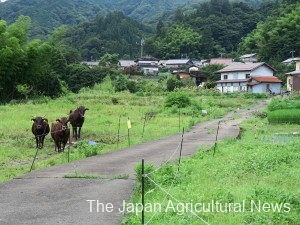TOKYO, July 7 — The Food and Agriculture Organization of the United Nations announced on July 6 that it has newly designated the fallen leaves compost agroforestry in the Musashino district of Saitama Prefecture and the traditional Tajima cattle raising system in the Mikata district of Hyogo Prefecture as Globally Important Agricultural Heritage Systems (GIAHS).
The Musashino district composts fallen leaves collected from woods adjacent to agricultural fields to make fertilizers for cultivating sweet potatoes, while the Mikata district hands down the traditional farming method for raising cattle, having established Japan’s first cattle lineage register in 1898.
The GIAHS initiative gives recognition to areas which preserve agricultural technologies and landscapes of historical significance. In Japan, 15 sites in 14 prefectures have been designated as GIAHS so far, including the latest two.
The Musashino district, comprising four municipalities such as the city of Kawagoe and the town of Miyoshi, has continued to adopt since the 17th century during the Edo Period the farming method of using leaves that fell from deciduous trees planted on flat land as compost. The area is characterized by the landscape of woodlands, fields and farmhouses lining up neatly.
Isao Hayashi, who heads a council campaigning for the area to be designated as the GIAHS, said, “We are very happy that the farming method of composting fallen leaves, which has been passed down for more than 300 years, has earned a global reputation. This is the result of efforts made by those involved, including farmers who have been implementing the system over many generations.”
The Mikata district, made up of the towns of Kami and Shinonsen, passes down its unique genetic resource for Tajima wagyu cattle raised in the prefecture.
The area was designated as the GIAHS for preserving the ecosystem by pasturing cattle and composting their manure.
Tetsuo Ohtagaki, head of JA Tajima, a local agricultural cooperative, and deputy chairman of a council campaigning for the area to be designated as GIAHS, released a statement jointly with others in response to the designation.
“The unique raising system for Tajima cattle bred in Mikata which has been built up by our predecessors was highly evaluated globally, and it is a great accomplishment which could not have been achieved without the efforts of those involved,” the statement said.
“Wagyu Olympics” which judges the excellence of branded cattle from all over Japan took place.
Watch and try to unveil the mystery of Japanese Wagyu. English, French and Chinese Subtitles are available (Spoken only in Japanese).-
Most Popular(Last 30 days)
- Number of young new farmers in Japan dips below 20,000 in 2018, fight over new workers with other industries gets severer 76 views
- ZEN-NOH completes lineup of Nippon Yell brand gummy candies from Japan’s all 47 prefectures 65 views
- 【News】 Fruit tree science institute releases new apple variety with pink flesh (Jan. 22, 2014) 48 views
- It’s mysterious circles in Japan! Drone captures circles of trees 44 views
- Nagano successfully develops new pink, rich, crispy apple, expecting to discover new use 43 views
- 【News】 Convey your love with “sweetheart plants” (Feb. 6, 2014) 35 views
- Strawberry-less Christmas cakes being sold due to short strawberry supply in high-demand season 33 views
- Neko-chigura cat cradles becoming increasingly popular among cats and cat lovers in Japan 32 views
- Farmers hold tractor rallies in Hiroshima and Yamagata calling for income security 30 views
- New columnar apple variety developed in Japan 29 views
Tags
Archive



